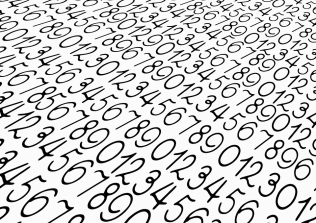 Fermat’s Last Theorem is one of the most celebrated problems in mathematics. It is a problem in the field of Number Theory that’s very simple to understand, yet extremely difficult to solve. In fact, it’s so difficult that it remained unsolved for 358 years even though it got a lot of attention from some of the best mathematicians in history. Pierre de Fermat first came up with it in 1637. It remained a conjecture because he didn’t provide any proof. Let’s go ahead and explore this labyrinth, shall we? Continue reading “Chasing Fermat’s Last Theorem”
Fermat’s Last Theorem is one of the most celebrated problems in mathematics. It is a problem in the field of Number Theory that’s very simple to understand, yet extremely difficult to solve. In fact, it’s so difficult that it remained unsolved for 358 years even though it got a lot of attention from some of the best mathematicians in history. Pierre de Fermat first came up with it in 1637. It remained a conjecture because he didn’t provide any proof. Let’s go ahead and explore this labyrinth, shall we? Continue reading “Chasing Fermat’s Last Theorem”
Category: Mathematics
Dissecting Diophantine Equations
 The word Diophantine refers to Diophantus, the third century mathematician from Alexandria. Numbers are the fundamental building blocks of mathematics, so he started thinking about problems for which we need integer solutions. For example, how many horses do we need to achieve a particular task? Even if the exact answer is 15.5, we cannot really cut the last horse into half. So he started studying these problems in order to develop a sound framework around it. This went on to become one of the most enigmatic and endearing fields in the history of mathematics. Diophantine equations have become so fundamental that we cannot imagine our world without them. Let’s go ahead and see what they are all about, shall we? Continue reading “Dissecting Diophantine Equations”
The word Diophantine refers to Diophantus, the third century mathematician from Alexandria. Numbers are the fundamental building blocks of mathematics, so he started thinking about problems for which we need integer solutions. For example, how many horses do we need to achieve a particular task? Even if the exact answer is 15.5, we cannot really cut the last horse into half. So he started studying these problems in order to develop a sound framework around it. This went on to become one of the most enigmatic and endearing fields in the history of mathematics. Diophantine equations have become so fundamental that we cannot imagine our world without them. Let’s go ahead and see what they are all about, shall we? Continue reading “Dissecting Diophantine Equations”
Understanding Catalan’s Conjecture
 Numbers are deceptively simple. We use them everyday in a variety of contexts. It’s beautiful how there are so many mysteries hidden inside these numbers. Catalan’s Conjecture is a mathematical problem that’s really easy to understand, but extremely difficult to prove. In fact, it took around 158 years to come up with a mathematical proof. It was Preda Mihăilescu, the amazing Romanian mathematician, who came up with a proof in 2002. In solving these problems, mathematicians come up with profound ideas and formulations that impact many fields within mathematics. Let’s go ahead and peel this metaphorical onion, shall we? Continue reading “Understanding Catalan’s Conjecture”
Numbers are deceptively simple. We use them everyday in a variety of contexts. It’s beautiful how there are so many mysteries hidden inside these numbers. Catalan’s Conjecture is a mathematical problem that’s really easy to understand, but extremely difficult to prove. In fact, it took around 158 years to come up with a mathematical proof. It was Preda Mihăilescu, the amazing Romanian mathematician, who came up with a proof in 2002. In solving these problems, mathematicians come up with profound ideas and formulations that impact many fields within mathematics. Let’s go ahead and peel this metaphorical onion, shall we? Continue reading “Understanding Catalan’s Conjecture”
Ergodicity In The World Of IoT
 Ergodicity is one of the most important concepts in statistics. More importantly, it has a lot of real world applications. In this case, it’s applicable to the staggering number of internet connected devices in the world of Internet of Things (IoT). Most of the experiments conducted by research labs, businesses, and marketing agencies often rely on statistics to compile the results. This can be about a set of customers, voters, viewers, or any other segment. Ever wondered why the results are often inaccurate? One of the main reasons is the underlying assumption about ergodicity. What exactly is it? Continue reading “Ergodicity In The World Of IoT”
Ergodicity is one of the most important concepts in statistics. More importantly, it has a lot of real world applications. In this case, it’s applicable to the staggering number of internet connected devices in the world of Internet of Things (IoT). Most of the experiments conducted by research labs, businesses, and marketing agencies often rely on statistics to compile the results. This can be about a set of customers, voters, viewers, or any other segment. Ever wondered why the results are often inaccurate? One of the main reasons is the underlying assumption about ergodicity. What exactly is it? Continue reading “Ergodicity In The World Of IoT”
Cauchy Sequences In The Real World
 Sequences occur everywhere in our daily life. Some of the examples include sensor data, stock market quotes, speech signals, and many more. A sequence is a collection of elements where each element is indexed. Repetitions are allowed in this case, which means any element can reappear in a given sequence. If we look closely, we can see that sequences are rich in information. In theory, we can design sequences with amazing characteristics and study them. This allows us to approximate real world processes using these sequences so that we can estimate what’s going to happen in the future. Cauchy sequence is one such sequence that’s very fundamental to a lot of fields. Let’s dig deeper and see why it’s relevant, shall we? Continue reading “Cauchy Sequences In The Real World”
Sequences occur everywhere in our daily life. Some of the examples include sensor data, stock market quotes, speech signals, and many more. A sequence is a collection of elements where each element is indexed. Repetitions are allowed in this case, which means any element can reappear in a given sequence. If we look closely, we can see that sequences are rich in information. In theory, we can design sequences with amazing characteristics and study them. This allows us to approximate real world processes using these sequences so that we can estimate what’s going to happen in the future. Cauchy sequence is one such sequence that’s very fundamental to a lot of fields. Let’s dig deeper and see why it’s relevant, shall we? Continue reading “Cauchy Sequences In The Real World”
Measuring The Memory Of Time Series Data
 Time series data has memory. It remembers what happened in the past and avenge any wrongdoings! Can you believe it? Okay the avenging part may not be true, but it definitely remembers the past. The “memory” refers to how strongly the past can influence the future in a given time series variable. If it has a strong memory, then we know that analyzing the past would be really useful to us because it can tell us what’s going to happen in the future. If you need a quick refresher, you can check out my blog post where I talked about memory in time series data. We have a high level understanding of how we can classify time series data into short memory and long memory, but how do we actually measure the memory? Continue reading “Measuring The Memory Of Time Series Data”
Time series data has memory. It remembers what happened in the past and avenge any wrongdoings! Can you believe it? Okay the avenging part may not be true, but it definitely remembers the past. The “memory” refers to how strongly the past can influence the future in a given time series variable. If it has a strong memory, then we know that analyzing the past would be really useful to us because it can tell us what’s going to happen in the future. If you need a quick refresher, you can check out my blog post where I talked about memory in time series data. We have a high level understanding of how we can classify time series data into short memory and long memory, but how do we actually measure the memory? Continue reading “Measuring The Memory Of Time Series Data”
What Is Pareto Optimality
 Let’s consider a business deal where there are multiple parties negotiating the terms. In such a situation, it’s usually not possible for every single party to get everything it wants. They need to optimize their demands so that everyone comes out with something positive. Similar situations arise across many areas of engineering where we have to deal with many resources and we need to make a trade off based on cost, quality, speed, and so on. How do we model this problem and decide the optimal state of affairs? This is where the concept of Pareto Optimality comes into picture. Continue reading “What Is Pareto Optimality”
Let’s consider a business deal where there are multiple parties negotiating the terms. In such a situation, it’s usually not possible for every single party to get everything it wants. They need to optimize their demands so that everyone comes out with something positive. Similar situations arise across many areas of engineering where we have to deal with many resources and we need to make a trade off based on cost, quality, speed, and so on. How do we model this problem and decide the optimal state of affairs? This is where the concept of Pareto Optimality comes into picture. Continue reading “What Is Pareto Optimality”
What Is Long Memory In Time Series Analysis
 We encounter time series data very frequently in the real world. Some common examples include real time sensors, surveillance video, stock market, astrophysics, speech recognition, and so on. In order to study time series data, we try to extract various characteristics that tend to define it. One of the most important things to think about is the dependence between various points in the time series data. Is there any dependence between the values in the time series data? If so, how far apart in time do they have to be in order to affect each other? Understanding these aspects will open up new doors in terms of how we analyze the data. This is where the concept of long memory comes into picture. Let’s dig a little deeper and understand it, shall we? Continue reading “What Is Long Memory In Time Series Analysis”
We encounter time series data very frequently in the real world. Some common examples include real time sensors, surveillance video, stock market, astrophysics, speech recognition, and so on. In order to study time series data, we try to extract various characteristics that tend to define it. One of the most important things to think about is the dependence between various points in the time series data. Is there any dependence between the values in the time series data? If so, how far apart in time do they have to be in order to affect each other? Understanding these aspects will open up new doors in terms of how we analyze the data. This is where the concept of long memory comes into picture. Let’s dig a little deeper and understand it, shall we? Continue reading “What Is Long Memory In Time Series Analysis”
Estimating The Predictability Of Time Series Data – Part II
 In the previous blog post, we discussed various types of time series data. We understood the concepts of stationarity and shocks. In this blog post, we will continue to discuss how we can estimate the predictability of time series data. People say that future is unpredictable. But that’s grossly reductive! What they actually mean to say is — I’m blindly assuming that my time series data is non-stationary, so I cannot accurately predict what’s going to happen in the future. Predicting future values can open a lot of doors in the Internet of Things (IoT) ecosystem. Before we can forecast future values, it’s important to determine if the time series data exhibits any properties that can be modeled. If not, we are just dealing with chaos and no model will be good enough. But a lot of data in the real world exhibits patterns, so we just need to look at it the right way. Let’s see how we can check if the given time series data has any underlying trends, shall we? Continue reading “Estimating The Predictability Of Time Series Data – Part II”
In the previous blog post, we discussed various types of time series data. We understood the concepts of stationarity and shocks. In this blog post, we will continue to discuss how we can estimate the predictability of time series data. People say that future is unpredictable. But that’s grossly reductive! What they actually mean to say is — I’m blindly assuming that my time series data is non-stationary, so I cannot accurately predict what’s going to happen in the future. Predicting future values can open a lot of doors in the Internet of Things (IoT) ecosystem. Before we can forecast future values, it’s important to determine if the time series data exhibits any properties that can be modeled. If not, we are just dealing with chaos and no model will be good enough. But a lot of data in the real world exhibits patterns, so we just need to look at it the right way. Let’s see how we can check if the given time series data has any underlying trends, shall we? Continue reading “Estimating The Predictability Of Time Series Data – Part II”
Estimating The Predictability Of Time Series Data – Part I
 Time series data refers to a sequence of measurements made over time. The frequency of these measurements are usually fixed, say once every second or once every hour. We encounter time series data in a variety of scenarios in the real world. Some examples include stock market data, sensor data, speech data, and so on. People like to build forecasting models for time series data. This is very relevant in modeling data in the world of Internet of Things (IoT). Based on the past data, they want to predict what’s going to happen in the future. Once of the most important questions is to see whether or not we can predict something in the first place. How do we determine that? How do we check if there are underlying patterns in the time series data? Continue reading “Estimating The Predictability Of Time Series Data – Part I”
Time series data refers to a sequence of measurements made over time. The frequency of these measurements are usually fixed, say once every second or once every hour. We encounter time series data in a variety of scenarios in the real world. Some examples include stock market data, sensor data, speech data, and so on. People like to build forecasting models for time series data. This is very relevant in modeling data in the world of Internet of Things (IoT). Based on the past data, they want to predict what’s going to happen in the future. Once of the most important questions is to see whether or not we can predict something in the first place. How do we determine that? How do we check if there are underlying patterns in the time series data? Continue reading “Estimating The Predictability Of Time Series Data – Part I”